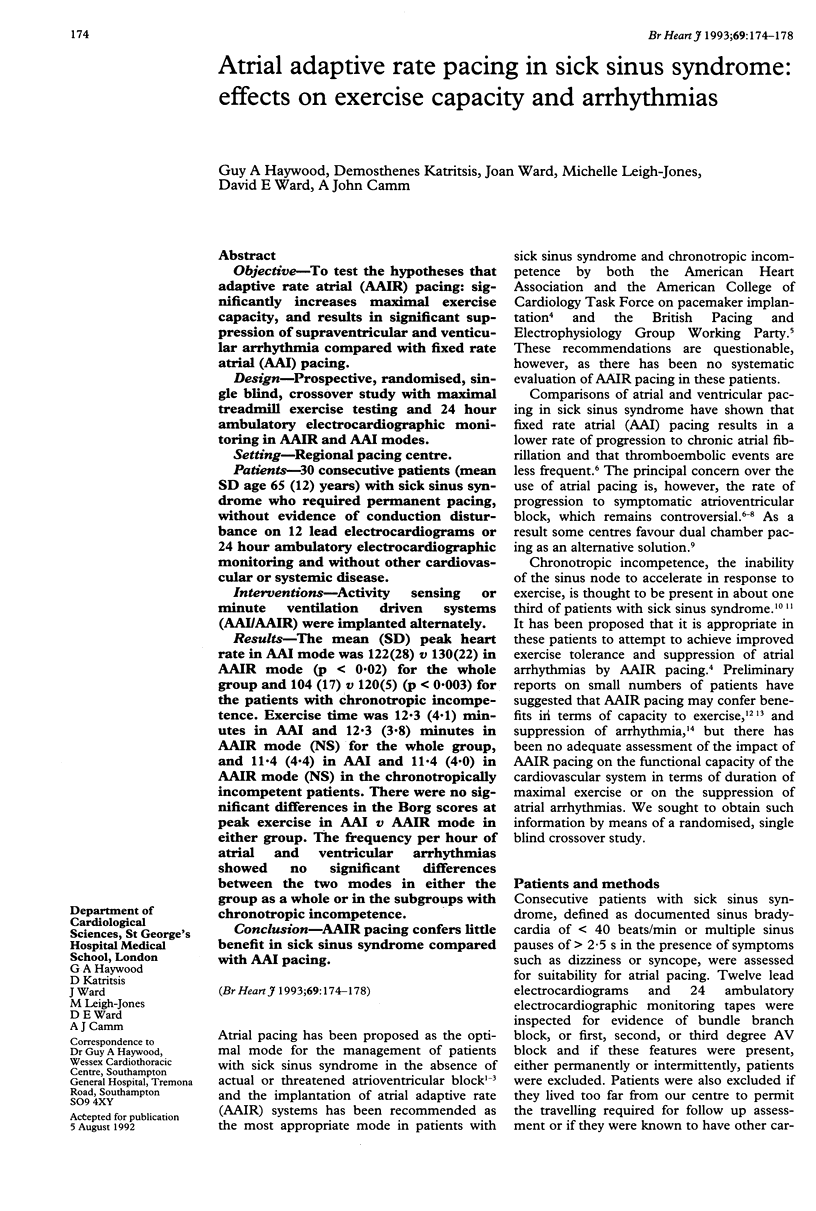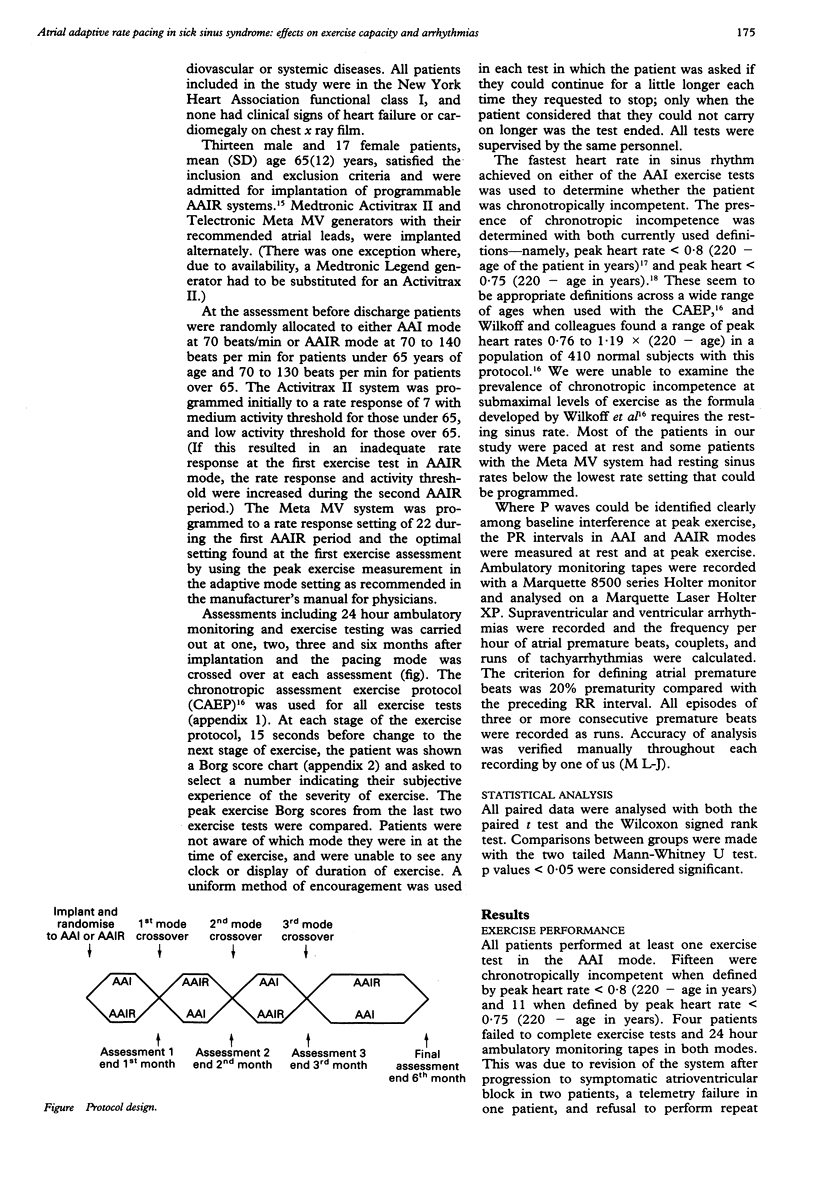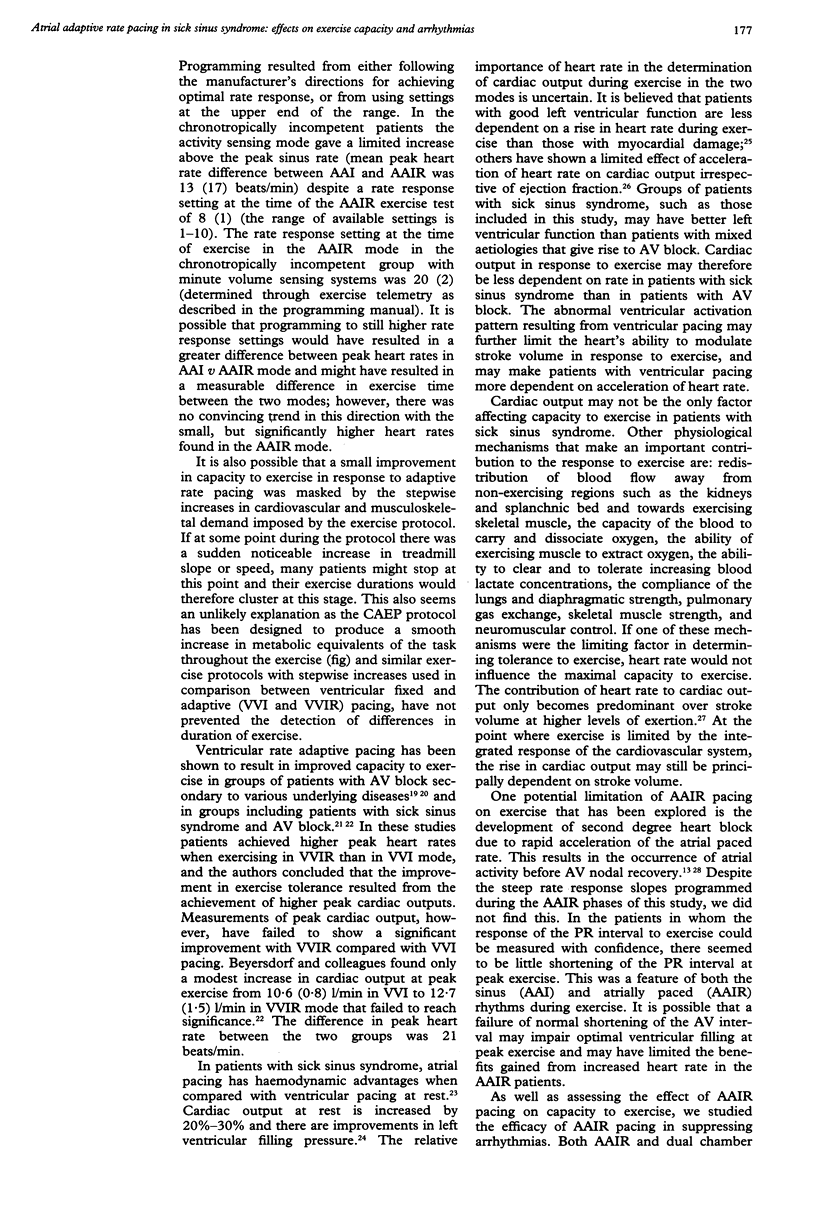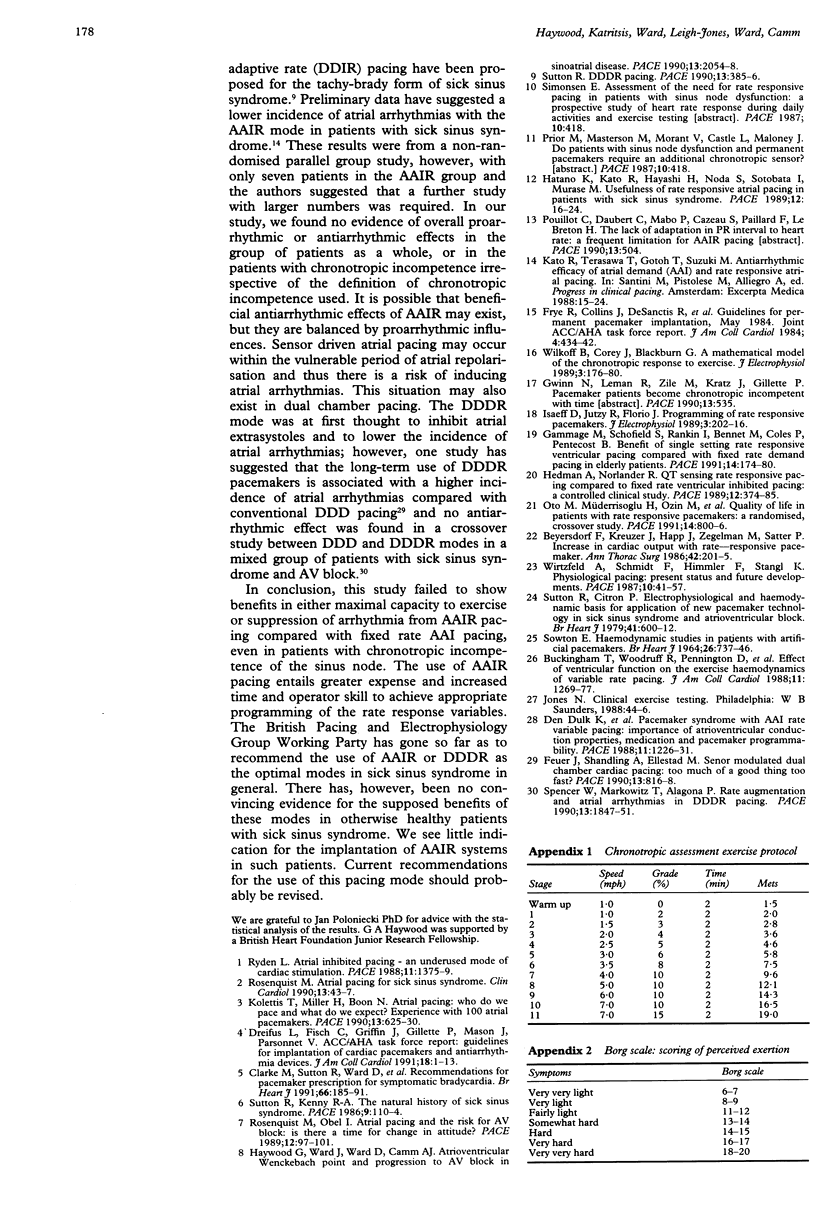Abstract
OBJECTIVE--To test the hypotheses that adaptive rate atrial (AAIR) pacing: significantly increases maximal exercise capacity, and results in significant suppression of supraventricular and ventricular arrhythmia compared with fixed rate atrial (AAI) pacing. DESIGN--Prospective, randomised, single blind, crossover study with maximal treadmill exercise testing and 24 hour ambulatory electrocardiographic monitoring in AAIR and AAI modes. SETTING--Regional pacing centre. PATIENTS--30 consecutive patients (mean SD age 65 (12) years) with sick sinus syndrome who required permanent pacing, without evidence of conduction disturbance on 12 lead electrocardiograms or 24 hour ambulatory electrocardiographic monitoring and without other cardiovascular or systemic disease. INTERVENTIONS--Activity sensing or minute ventilation driven systems (AAI/AAIR) were implanted alternately. RESULTS--The mean (SD) peak heart rate in AAI mode was 122(28)v 130(22) in AAIR mode (p < 0.02) for the whole group and 104(17) v 120(5) (p < 0.003) for the patients with chronotropic incompetence. Exercise time was 12.3 (4.1) minutes in AAI and 12.3 (3.8) minutes in AAIR mode (NS) in the chronotropically incompetent patients. There were no significant differences in the Borg scores at peak exercise in AAI v AAIR mode in either group. The frequency per hour of atrial and ventricular arrhythmias showed no significant differences between the two modes in either the group as a whole or in the subgroups with chronotropic incompetence. CONCLUSION--AAIR pacing confers little benefit in sick sinus syndrome compared with AAI pacing.
Full text
PDF




Selected References
These references are in PubMed. This may not be the complete list of references from this article.
- Beyersdorf F., Kreuzer J., Happ T. A., Zegelman M., Satter P. Increase in cardiac output with rate-responsive pacemaker. Ann Thorac Surg. 1986 Aug;42(2):201–205. doi: 10.1016/s0003-4975(10)60519-x. [DOI] [PubMed] [Google Scholar]
- Buckingham T. A., Woodruff R. C., Pennington D. G., Redd R. M., Janosik D. L., Labovitz A. J., Graves R., Kennedy H. L. Effect of ventricular function on the exercise hemodynamics of variable rate pacing. J Am Coll Cardiol. 1988 Jun;11(6):1269–1277. doi: 10.1016/0735-1097(88)90291-4. [DOI] [PubMed] [Google Scholar]
- Dreifus L. S., Fisch C., Griffin J. C., Gillette P. C., Mason J. W., Parsonnet V. Guidelines for implantation of cardiac pacemakers and antiarrhythmia devices. A report of the American College of Cardiology/American Heart Association Task Force on Assessment of Diagnostic and Therapeutic Cardiovascular Procedures (Committee on Pacemaker Implantation). J Am Coll Cardiol. 1991 Jul;18(1):1–13. doi: 10.1016/s0735-1097(10)80209-8. [DOI] [PubMed] [Google Scholar]
- Feuer J. M., Shandling A. H., Ellestad M. H. Sensor-modulated dual chamber cardiac pacing: too much of a good thing too fast? Pacing Clin Electrophysiol. 1990 Jun;13(6):816–818. doi: 10.1111/j.1540-8159.1990.tb02109.x. [DOI] [PubMed] [Google Scholar]
- Gammage M., Schofield S., Rankin I., Bennett M., Coles P., Pentecost B. Benefit of single setting rate responsive ventricular pacing compared with fixed rate demand pacing in elderly patients. Pacing Clin Electrophysiol. 1991 Feb;14(2 Pt 1):174–180. doi: 10.1111/j.1540-8159.1991.tb05087.x. [DOI] [PubMed] [Google Scholar]
- Hatano K., Kato R., Hayashi H., Noda S., Sotobata I., Murase M. Usefulness of rate responsive atrial pacing in patients with sick sinus syndrome. Pacing Clin Electrophysiol. 1989 Jan;12(1 Pt 1):16–24. doi: 10.1111/pace.1989.12.p1.16. [DOI] [PubMed] [Google Scholar]
- Haywood G. A., Ward J., Ward D. E., Camm A. J. Atrioventricular Wenckebach point and progression to atrioventricular block in sinoatrial disease. Pacing Clin Electrophysiol. 1990 Dec;13(12 Pt 2):2054–2058. doi: 10.1111/j.1540-8159.1990.tb06941.x. [DOI] [PubMed] [Google Scholar]
- Hedman A., Nordlander R. QT sensing rate responsive pacing compared to fixed rate ventricular inhibited pacing: a controlled clinical study. Pacing Clin Electrophysiol. 1989 Feb;12(2):374–385. doi: 10.1111/j.1540-8159.1989.tb02671.x. [DOI] [PubMed] [Google Scholar]
- Kolettis T. M., Miller H. C., Boon N. A. Atrial pacing: who do we pace and what do we expect? Experiences with 100 atrial pacemakers. Pacing Clin Electrophysiol. 1990 May;13(5):625–630. doi: 10.1111/j.1540-8159.1990.tb02079.x. [DOI] [PubMed] [Google Scholar]
- Recommendations for pacemaker prescription for symptomatic bradycardia. Report of a working party of the British Pacing and Electrophysiology Group. Br Heart J. 1991 Aug;66(2):185–191. [PMC free article] [PubMed] [Google Scholar]
- Rosenqvist M. Atrial pacing for sick sinus syndrome. Clin Cardiol. 1990 Jan;13(1):43–47. doi: 10.1002/clc.4960130108. [DOI] [PubMed] [Google Scholar]
- Rosenqvist M., Obel I. W. Atrial pacing and the risk for AV block: is there a time for change in attitude? Pacing Clin Electrophysiol. 1989 Jan;12(1 Pt 1):97–101. doi: 10.1111/pace.1989.12.p1.97. [DOI] [PubMed] [Google Scholar]
- Rydén L. Atrial inhibited pacing--an underused mode of cardiac stimulation. Pacing Clin Electrophysiol. 1988 Oct;11(10):1375–1379. doi: 10.1111/j.1540-8159.1988.tb04983.x. [DOI] [PubMed] [Google Scholar]
- SOWTON E. HAEMODYNAMIC STUDIES IN PATIENTS WITH ARTIFICIAL PACEMAKERS. Br Heart J. 1964 Nov;26:737–746. doi: 10.1136/hrt.26.6.737. [DOI] [PMC free article] [PubMed] [Google Scholar]
- Spencer W. H., 3rd, Markowitz T., Alagona P. Rate augmentation and atrial arrhythmias in DDDR pacing. Pacing Clin Electrophysiol. 1990 Dec;13(12 Pt 2):1847–1851. doi: 10.1111/j.1540-8159.1990.tb06901.x. [DOI] [PubMed] [Google Scholar]
- Sutton R., Citron P. Electrophysiological and haemodynamic basis for application of new pacemaker technology in sick sinus syndrome and atrioventricular block. Br Heart J. 1979 May;41(5):600–612. doi: 10.1136/hrt.41.5.600. [DOI] [PMC free article] [PubMed] [Google Scholar]
- Sutton R. DDDR pacing. Pacing Clin Electrophysiol. 1990 Apr;13(4):385–387. doi: 10.1111/j.1540-8159.1990.tb02051.x. [DOI] [PubMed] [Google Scholar]
- Wirtzfeld A., Schmidt G., Himmler F. C., Stangl K. Physiological pacing: present status and future developments. Pacing Clin Electrophysiol. 1987 Jan;10(1 Pt 1):41–57. doi: 10.1111/j.1540-8159.1987.tb05923.x. [DOI] [PubMed] [Google Scholar]
- den Dulk K., Lindemans F. W., Brugada P., Smeets J. L., Wellens H. J. Pacemaker syndrome with AAI rate variable pacing: importance of atrioventricular conduction properties, medication, and pacemaker programmability. Pacing Clin Electrophysiol. 1988 Aug;11(8):1226–1233. doi: 10.1111/j.1540-8159.1988.tb03976.x. [DOI] [PubMed] [Google Scholar]


